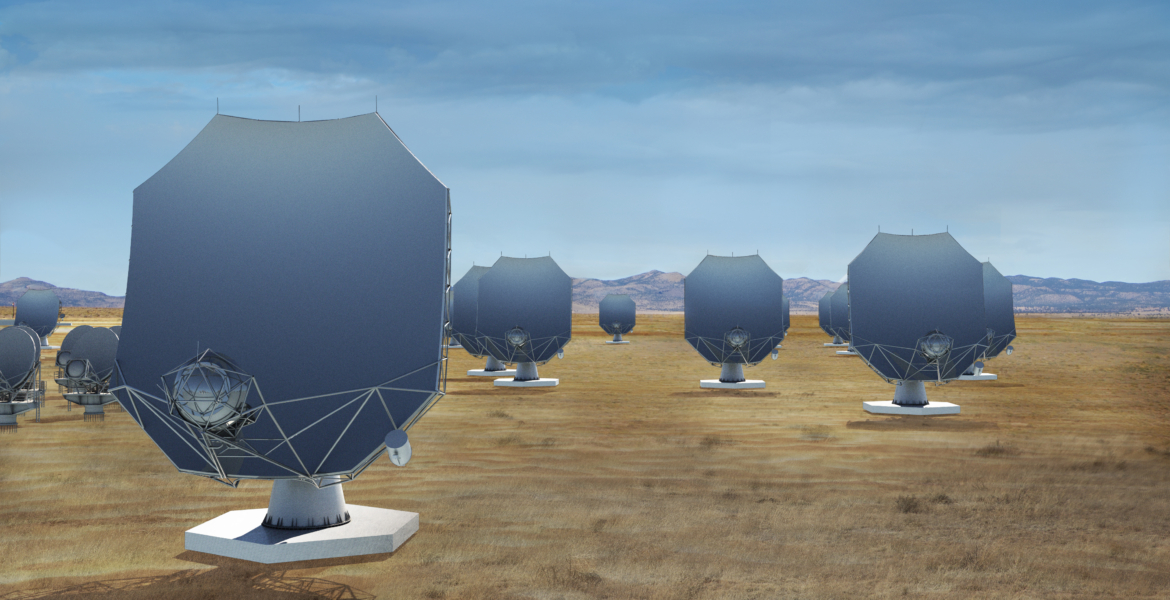The U.S. National Science Foundation National Radio Astronomy Observatory (NSF NRAO), in partnership with several leading Mexican universities and research institutes, has announced a series of landmark agreements and meetings aimed at advancing Mexico’s role in the Next Generation Very Large Array (ngVLA) project.
Recent News
Astronomers Discover a Superheated Star Factory in the Early Universe
Astronomers have uncovered a previously unknown, extreme kind of star factory by taking the temperature of a distant galaxy using the ALMA telescope. The galaxy is glowing intensely in superheated cosmic dust while forming stars 180 times faster than our own Milky Way.
Astronomers Share Largest Molecular Survey To-date: GOTHAM Legacy Data Goes Public
Astronomers in the “GBT Observations of TMC-1: Hunting Aromatic Molecules” research survey, known as GOTHAM, have released a spectral line survey with largest amount of telescope time ever conducted, charting more than 100 molecular species only found in deep space.
Next-Generation Very Large Array Antenna Design to be Used By German Astronomers

Bavarian state government and regional universities fund construction of antenna on Germany’s highest peak
The U.S. National Science Foundation National Radio Astronomy Observatory has announced a significant collaboration with the Bavarian State Government to construct a cutting-edge radio telescope atop Germany’s highest mountain. This radio telescope will use the design of the proposed NSF NRAO’s Next Generation Very Large Array (ngVLA).
Known as the Wetterstein Millimeter Telescope (WMT), this antenna could interface with the NSF NRAO’s proposed ngVLA, while also having the capability to function independently. The WMT will be strategically positioned at the summit of the Zugspitze, offering exceptional observing conditions due to its high altitude and clear skies. This location can significantly improve the antenna’s sensitivity and resolution across the millimeter wavelength range, allowing for groundbreaking astronomical observations.
The project is funded by the Bavarian State Government, as announced in their recent press release. “The Wetterstein Millimeter Telescope will be an exciting research facility and further opens up the possibility of one day establishing a global ngVLA network,” said ngVLA Project Scientist Eric Murphy of the NSF NRAO. “Its placement on the Zugspitze provides unparalleled observing conditions, which can enhance the overall sensitivity and resolution of the ngVLA. This may enable astronomers to conduct unprecedented research across a wide range of astrophysical topics.”
The WMT is not only a significant scientific achievement in its own right, but also has the potential to act as a catalyst for the development of a larger, dedicated interferometric array. Such an array, which could potentially include up to 16 antennas, would leverage the considerable astronomical expertise and infrastructure already present in Germany, and could expand the NSF NRAO’s proposed ngVLA reach and scientific impact.
About NRAO
The National Radio Astronomy Observatory is a facility of the U.S. National Science Foundation, operated under cooperative agreement by Associated Universities, Inc.
This news article was originally published on the NRAO website on February 10, 2025.
Recent News
NSF National Radio Astronomy Observatory and Mexican Institutions Sign Historic Agreements to Advance ngVLA Collaboration
The U.S. National Science Foundation National Radio Astronomy Observatory (NSF NRAO), in partnership with several leading Mexican universities and research institutes, has announced a series of landmark agreements and meetings aimed at advancing Mexico’s role in the Next Generation Very Large Array (ngVLA) project.
Astronomers Discover a Superheated Star Factory in the Early Universe
Astronomers have uncovered a previously unknown, extreme kind of star factory by taking the temperature of a distant galaxy using the ALMA telescope. The galaxy is glowing intensely in superheated cosmic dust while forming stars 180 times faster than our own Milky Way.
Astronomers Share Largest Molecular Survey To-date: GOTHAM Legacy Data Goes Public
Astronomers in the “GBT Observations of TMC-1: Hunting Aromatic Molecules” research survey, known as GOTHAM, have released a spectral line survey with largest amount of telescope time ever conducted, charting more than 100 molecular species only found in deep space.
